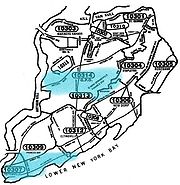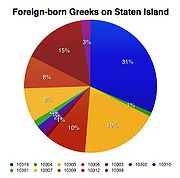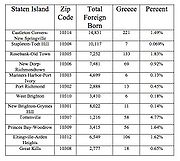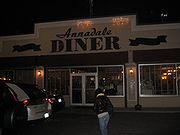From The Peopling of New York City
Contents |
Overview
The Greek community on Staten Island makes up about 0.16% of the total population on Staten Island. The most dense zip code of the Greek population on Staten Island is 10307 (Tottenville), however the largest total population exists in 10314 (Casleton Corners-New Springville). Between 1890 and 1900 about 16,000 immigrants arrived from Greece with 1,300 residing in the state of New York. However due to limited transportation to and from Staten Island many Greeks were not able to settle here right away. Some prominent immigrants from the Greek community are Emmanuel Katsoris owner of, then Candy Square Kitchen, Supreme Chocolatier. There is also Catherine Cass, who was named Advance Woman of Achievement by the Staten Island Advance, and William Cass who was President of Fanning Enterprises, Incorporated.
Demographics
Greeks were among the last of the Europeans to immigrate to America. The people of Greece came to Staten Island in “waves,” during the years of 1900-1925, 1930-1955, and 1960-present. The Greeks immigrated due to economic reasons; to make a better life for themselves and their family. The “second wave” of Greeks were not from Greece itself, they were Greeks who came to Staten Island to spend the summer, such as the Petrides family. The “third wave” of Greeks was mostly from Brooklyn, that traveled to Staten Island once the Verrazano Bridge was opened.
According to Staten Island's Greek Community by Christine Charitis, Greeks came to America out of economic need. Some came from small islands where there was little land available for their families, while others came for democratic freedom. They possessed few skills and knew no English.Many Greeks who settled on Staten Island worked hard to help their families immigrate over to America. The farming part of the Hellenistic community concentrated around Bulls Head and New Springville, while they opened their businesses in the Port Richmond area.
History
Between the years 1912 and 1913, Greece was involved in the Balkan Wars and as a result, caused an increase in land and population. A feud between King Constantine I and the Prime Minister Eleftherios Venizelos about Greece’s foreign policy divided the country into two politically opposed groups. After World War II, Greece fought against Turkey and led to several hundred thousand deaths. On October 28, 1940, a Fascist Italy forced Greece to surrender, but the dictator, Ioannis Metaxas, refused. In the Greco-Italian War that followed this refusal, Greece repelled Italian troops into Albania, which gave the Allies a victory over the Axis Powers. However, this victory was short-lived because German troops infiltrated the country during the Battle of Greece. From 1941 to 1942, over 100,000 civilians died from starvation and in 1943 the entire Jewish population was sent to Nazi camps. When Greece was finally liberated, there was a civil war between the communist and anticommunist militaries, which led to a destroyed economy and ruthless social tension for the next 30 years.
Greeks were among the last of the Europeans to immigrate to America. According to Staten Island’s Greek Community by Christine Charitis, the people of Greece came to Staten Island in “waves,” during the years of 1900-1925, 1930-1955, and 1960-present. The Greeks immigrated due to economic reasons; to make a better life for themselves and their family. The “second wave” of Greeks were not from Greece itself, they were Greeks who came to Staten Island to spend the summer, such as the Petrides family. The “third wave” of Greeks was mostly from Brooklyn, that traveled to Staten Island once the Verrazano Bridge was opened.
After immigration, they were the most nationalistic ethnic group, and were distrustful of those that were not of Greek descent. Upon arrival, many worked as bootblacks, dish washers, and factory workers. Once they established themselves, they opened shoeshine flower shops, candy shops and ice cream parlors. However, none of their businesses contained Greek names, due to the fact that they were too ethnic for business purposes.
The People
Ellen Stark works as a Dean's assistant at the College of Staten Island. She is a second generation Greek who moved to Staten Island with her husband twenty years ago. Her grandparents came to the United States around 1910 and settled with family in the Boston area with little money and belongings. They immigrated here for the same reason everyone else did at the time: for a better life. She believes that the celebration of Easter is a very important tradition and is considered more important than Christmas. The Easter celebration in the Greek Orthodox Church on Staten Island starts on Holy Wednesday and concludes with the midnight Easter Liturgy. During the Good Friday mass, Jesus is placed on the cross and during the night mass, Jesus is placed in a coffin, called the epitaph, which is decorated with carnations. The coffin, followed by the priest, followed by the chanter, choir, maidens, altar boys and the community walk around the outside of the Church. When they re-enter the Church, the members of the Church walk underneath the coffin for good luck and each receive a carnation from the priest. There is also a liturgy on Saturday afternoon, which is followed by a liturgy at midnight– the Easter mass. Due to the Holy Trinity Greek Orthodox Church, Ellen feels that the Greek community is extremely close knit on Staten Island. Due to everyone being Greek and having relatives from the same islands in Greece, their bond as a community is very strong. Also, the liturgies are done in an English-Greek mix, which forms relationships between those who do and do not speak Greek.
Gregory Lella is a student of the William E. Macaulay Honors College at the City University of New York (College of Staten Island campus). His family immigrated from Greece in the early 1900’s because of the Great War. Due to the language barrier, troubles arose when they first arrived in the United States. His great grandmother was almost denied entry into the country because she could not speak English. Although she had received a PhD in Greece, this was considered meaningless and was marked illiterate. Much of his heritage and traditions centers on the Greek Orthodox religion and church, with the holidays being a major focus. Easter is celebrated at a different time than the Catholic church and, in Greg’s family, a special Greek song is sung every year. He also gets to meet with family members he normally doesn’t see. As a child, he attended the annual Greek food with his family, where he ate food and met with other Greek children. Although the Greek lifestyle was not ingrained into his everyday life during his teen years, Greg tried to learn as much as possible about his heritage through books dealing with its history and customs. He also tries to stay up to date on current affairs in Greece, including their current debt crisis. Greg feels that his Greek heritage has affected him through religion. However, it has affected him through other means as well. Despite the fact that he can not speak Greek, he feels great pride of his descent. He likes being able to carry on conversations with certain Greeks that speak English and have enough knowledge on Greece’s history and way of life in order to keep up. “I’m in awe every time I think of all of the accomplishments of Greece. It’s an identity. That’s how it has shaped my life; it has shaped how I think of myself.”
Ethnic Stages
"Ethnic Stages" refers to the locations on Staten Island or within the community on which people display their community membership and identity. This can mean churches, community centers, specialized stores with products from the home country, restaurants that serve the community's cuisine, or other sorts of institutions.
The Annadale Diner is a Greek owned restaurant appropriately named for its location in the section of Staten Island named Annadale. Like in most, if not all places in America, Staten Island has diners. Almost all of these diners are Greek owned establishments, which have certain aspects that hail to back to Grecian culture while simultaneously are very “Americanized.”
The Annadale Diner is a diner just like an American Denny’s or Perkins, however it is more than that. It’s an ethnic institution that holds a certain portion no matter how big or small of the Greek community. It is also like no diner located on Staten Island, instead it’s atmosphere and food relate more to a restaurant, rather than to be associated with the term diner. The “Americanization” of the diner is obvious through the menu, which is like a melting pot of cultures. Not only does the establishment have Greek food, it has Italian, French, what people consider American, and many others. However it remains to be an “ethnic” institution via its décor, inclusion of Greek foods, and its lively Greek owner who is always around to check on his customers and have a chat.
Once the Greek community settled on Staten Island, they noticed that they lacked a place of worship. There was no place to hold liturgies or send the children for religious schooling. They came together to organize the buying of land and building of the Holy Trinity Greek Orthodox Church. In January 1930 they prepared for the construction of church that would be built on Richmond Avenue in Bulls Head. On May 25, 1930 the celebrated thyranixia (the opening of the doors). From that moment on, the church became a big part of the Greek community on Staten Island, and is used not only for liturgies, but for auctions, festivals, and dances.
Readings
1. Laliotou, Ioanna. Transatlantic Subjects: Acts of Migration and Cultures of Transnationalism between Greece and America. Chicago: University of Chicago, 2004.
2. Monos, Dimitris. The Greek Americans. New York: Chelsea House, 1988.
3. Fairchild, Henry Pratt. Greek Immigration to the United States. New Haven: Yale UP, 1911.
4. Steger, Frank Decatur. Emigration and Immigration Laws Affecting Greek, Armenian, and Turkish Immigrants to the United States. 1924.
5. Charitis, Christine Victoria. Staten Island's Greek Community. Charleston, SC: Arcadia, 2005.
6. Veglery, Anna. The Integration of Post-1965 Greek Immigrants to New York. 1987.
7. Veglery, Anna. Greeks in New York. 1980.
8. Nkosi, Joanna Karvonides. Greek Immigrants in the Fur Manufacturing Industry in New York City, 1887 to 1943 Class and Ethnicity at the Workplace. 1991.
9. Wallner, Rosemary. Greek Immigrants, 1890-1920. Mankato, Minn.: Blue Earth, 2003.
10. Voultsos, Mary. Greek Immigrant Passengers: 1885 - 1910. Worcester, Mass.: Voultsos, 1992.
11. Richard, Carl J. The Golden Age of the Classics in America: Greece, Rome, and the Antebellum United States. Cambridge, Mass.: Harvard UP, 2009.
12. Sant, Cassia Paul., and Constantina Bada. The Making of the Modern Greek Family: Marriage and Exchange in Nineteenth-century Athens. Cambridge: Cambridge UP, 1992.
13. Samuelson, James. Greece, Her Present Condition and Recent Progress. London, 1894.
14. Kostelenos, George C. Money and Output in Modern Greece: 1858-1938. Athens: Centre of Planning and Economic Research, 1995.
15. Lamington, Alexander, and John Ollivier. The Kingdom of Greece. London: Harrison, 1862.
16. Dedoussopoulos, A. A. Capitalism, Simple Commodity Production and Merchant Capital: The Political Economy of Greece in the 19th Century. Canterbury: University of Kent, 1985.
17. Carabott, Philip. Greek Society in the Making, 1863-1913: Realities, Symbols, and Visions. Aldershot, Hampshire, Great Britain: Variorum, 1997.
18. Kofas, Jon V. Financial Relations of Greece and the Great Powers, 1832-1862. Boulder [Colo.: East European Quarterly], 1981
19. Korres, M., and Charalampos Bouras. Athens: from the Classical Period to the Present Day (5th Century B.C.-A.D. 2000). 1st ed. New Castle, DE: Oak Knoll, 2003.
20. Smith, Michael Llewellyn. Athens: a Cultural and Literary History. Oxford: Signal, 2004.
21. Infoshare Online. Web. 14 Mar. 2010. <http://www.infoshare.org/>.
22. New York City Department of City Planning, The Newest New Yorkers 2000: Immigrant New York in the New Millenium
Further Research
Greeks -- New York (State) -- Richmond County -- History -- Pictorial works Immigrants -- New York (State) -- Richmond County -- History -- Pictorial works Greek Americans -- Genealogy United States -- Emigration and immigration Ships -- United States -- Passenger lists Social change -- Greece -- History -- 19th century -- Congresses Greece -- Politics and government -- 1863-1913 -- Congresses Money -- Greece -- History -- 19th century Civilization, Classical -- Study and teaching -- United States -- History -- 19th century Families -- Greece -- Athens -- History -- 19th century





